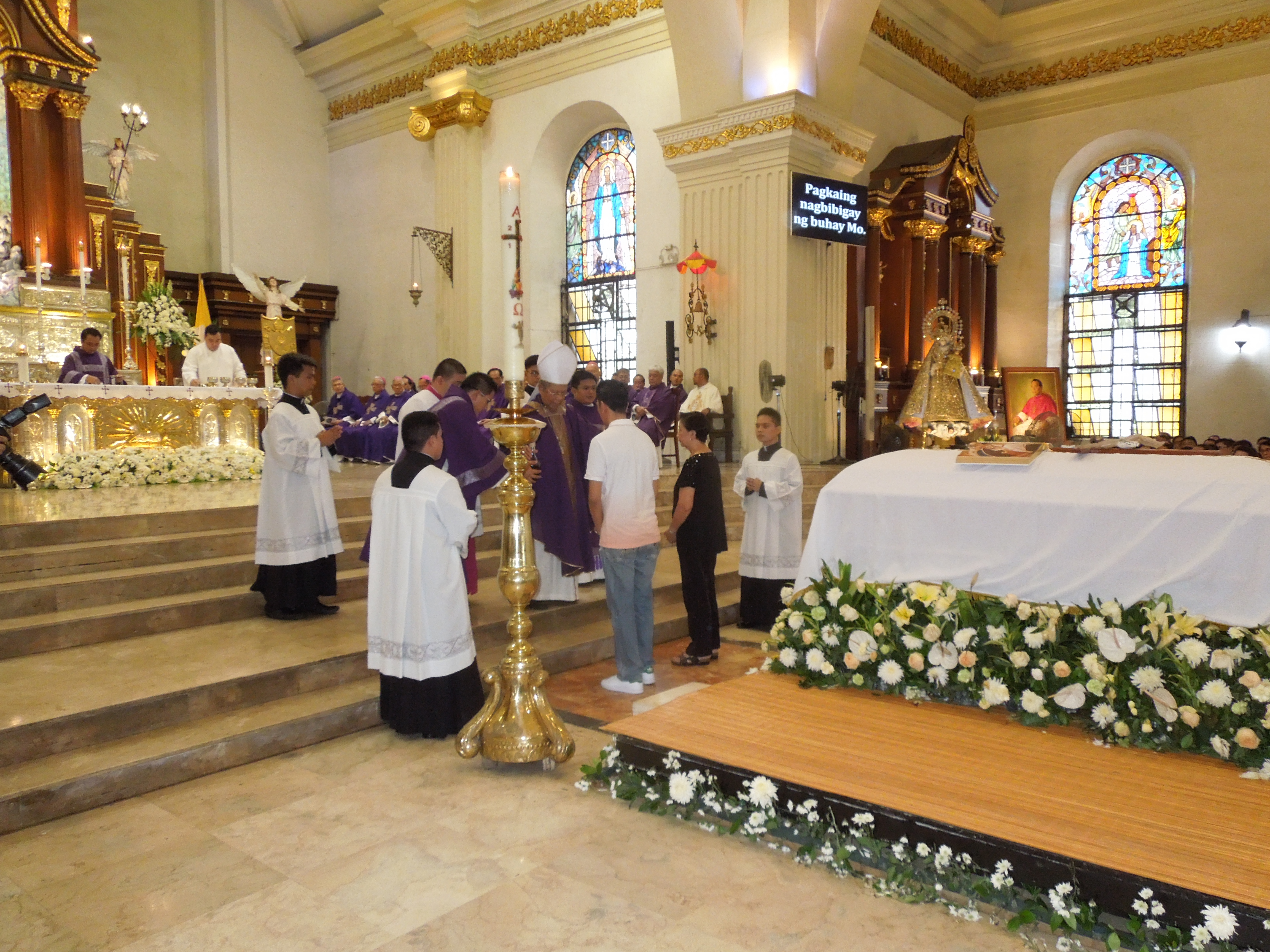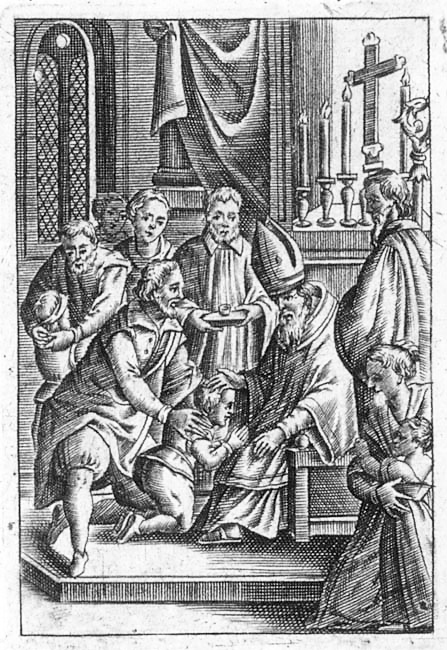|
Pontifical Sandals
Episcopal sandals, also known as pontifical sandals, are a Catholic pontifical vestment worn by bishops when celebrating liturgical functions according to the pre–Vatican II rubrics, for example a Tridentine Solemn Pontifical Mass. In shape, episcopal sandals are more like loafers than sandals. Liturgical stockings (''caligae'') are worn over the episcopal sandals and cover the episcopal sandals and the ankle. The sandals and stockings usually match the liturgical color of the Mass. However, when black vestments are worn, pontifical footwear is not used. After the Second Vatican Council, the episcopal sandals fell out of common use and are not mentioned in the rubrics of the post-Vatican II Mass. They are primarily seen in the most solemn form of Tridentine Mass. Episcopal sandals should not be confused with the velvet papal shoes, which Pope Benedict XVI reassumed. These evolved as the outdoor counterpart of the papal slippers, which are similar to the episcopal sandals, b ... [...More Info...] [...Related Items...] OR: [Wikipedia] [Google] [Baidu] |
Protonotary Apostolic
In the Roman Catholic Church, protonotary apostolic (PA; Latin: ''protonotarius apostolicus'') is the title for a member of the highest non-episcopal college of prelates in the Roman Curia or, outside Rome, an honorary prelate on whom the pope has conferred this title and its special privileges. An example is Prince Georg of Bavaria (1880–1943), who became in 1926 Protonotary by papal decree. History In late antiquity, there were in Rome seven regional notaries who, on the further development of the papal administration and the accompanying increase of the notaries, remained the supreme palace notaries of the papal chancery (''notarii apostolici'' or ''protonotarii''). In the Middle Ages, the protonotaries were very high papal officials and were often raised directly from this office to the cardinalate. Originally numbering seven, Pope Sixtus V (1585–90) increased their number to twelve. Their importance gradually diminished, and at the time of the French Revolution, th ... [...More Info...] [...Related Items...] OR: [Wikipedia] [Google] [Baidu] |
Bishop
A bishop is an ordained clergy member who is entrusted with a position of authority and oversight in a religious institution. In Christianity, bishops are normally responsible for the governance of dioceses. The role or office of bishop is called episcopacy. Organizationally, several Christian denominations utilize ecclesiastical structures that call for the position of bishops, while other denominations have dispensed with this office, seeing it as a symbol of power. Bishops have also exercised political authority. Traditionally, bishops claim apostolic succession, a direct historical lineage dating back to the original Twelve Apostles or Saint Paul. The bishops are by doctrine understood as those who possess the full priesthood given by Jesus Christ, and therefore may ordain other clergy, including other bishops. A person ordained as a deacon, priest (i.e. presbyter), and then bishop is understood to hold the fullness of the ministerial priesthood, given responsibility b ... [...More Info...] [...Related Items...] OR: [Wikipedia] [Google] [Baidu] |
Cardinal (Catholicism)
A cardinal ( la, Sanctae Romanae Ecclesiae cardinalis, literally 'cardinal of the Holy Roman Church') is a senior member of the clergy of the Catholic Church. Cardinals are created by the ruling pope and typically hold the title for life. Collectively, they constitute the College of Cardinals. Their most solemn responsibility is to elect a new pope in a conclave, almost always from among themselves (with a few historical exceptions), when the Holy See is vacant. During the period between a pope's death or resignation and the election of his successor, the day-to-day governance of the Holy See is in the hands of the College of Cardinals. The right to participate in a conclave is limited to cardinals who have not reached the age of 80 years by the day the vacancy occurs. In addition, cardinals collectively participate in papal consistories (which generally take place annually), in which matters of importance to the Church are considered and new cardinals may be created. Cardina ... [...More Info...] [...Related Items...] OR: [Wikipedia] [Google] [Baidu] |
Requiem Mass
A Requiem or Requiem Mass, also known as Mass for the dead ( la, Missa pro defunctis) or Mass of the dead ( la, Missa defunctorum), is a Mass of the Catholic Church offered for the repose of the soul or souls of one or more deceased persons, using a particular form of the Roman Missal. It is usually celebrated in the context of a funeral (where in some countries it is often called a Funeral Mass). Musical settings of the propers of the Requiem Mass are also called Requiems, and the term has subsequently been applied to other musical compositions associated with death, dying, and mourning, even when they lack religious or liturgical relevance. The term is also used for similar ceremonies outside the Roman Catholic Church, especially in Western Rite Orthodox Christianity, the Anglo-Catholic tradition of Anglicanism, and in certain Lutheran churches. A comparable service, with a wholly different ritual form and texts, exists in the Eastern Orthodox and Eastern Catholic church ... [...More Info...] [...Related Items...] OR: [Wikipedia] [Google] [Baidu] |
Vestment
Vestments are liturgical garments and articles associated primarily with the Christian religion, especially by Eastern Churches, Catholics (of all rites), Anglicans, and Lutherans. Many other groups also make use of liturgical garments; this was a point of controversy in the Protestant Reformation and sometimes since, in particular during the ritualist controversies in England in the 19th century. Origins of vestments In the early Christian churches, officers and leaders, like their congregations, wore the normal dress of civil life in the Greco-Roman world, although with an expectation that the clothing should be clean and pure during holy observances. From the 4th century onward, however, modifications began to be made to the form of the garments, and as secular fashions changed from the 6th century the church retained the original forms of their garments, although with separate development and with regional variations. Having separate, consecrated clothing for the cere ... [...More Info...] [...Related Items...] OR: [Wikipedia] [Google] [Baidu] |
Solemn Vespers
Vespers is a service of evening prayer, one of the canonical hours in Eastern Orthodox, Oriental Orthodox, Catholic (both Latin and Eastern), Lutheran, and Anglican liturgies. The word for this fixed prayer time comes from the Latin , meaning "evening". Vespers typically follows a set order that focuses on the performance of psalms and other biblical canticles. Eastern Orthodox services advertised as 'vespers' often conclude with compline, especially the all-night vigil. Performing these services together without break was also a common practice in medieval Europe, especially secular churches and cathedrals. Old English speakers translated the Latin word as , which became evensong in modern English. The term is now usually applied to the Anglican variant of the service that combines vespers with compline, following the conception of early sixteenth-century worshippers that conceived these as a single unit. The term can also apply to the pre-Reformation form of vespers or forms ... [...More Info...] [...Related Items...] OR: [Wikipedia] [Google] [Baidu] |
Confirmation
In Christian denominations that practice infant baptism, confirmation is seen as the sealing of the covenant created in baptism. Those being confirmed are known as confirmands. For adults, it is an affirmation of belief. It involves laying on of hands. Catholicism views confirmation as a sacrament. The sacrament is called chrismation in the Eastern Christianity. In the East it is conferred immediately after baptism. In Western Christianity, confirmation is ordinarily administered when a child reaches the age of reason or early adolescence. When an adult is baptized, the sacrament is conferred immediately after baptism in the same ceremony. Among those Christians who practice teen-aged confirmation, the practice may be perceived, secondarily, as a " coming of age" rite. In many Protestant denominations, such as the Anglican, Lutheran, Methodist and Reformed traditions, confirmation is a rite that often includes a profession of faith by an already baptized person. Confirmatio ... [...More Info...] [...Related Items...] OR: [Wikipedia] [Google] [Baidu] |
Ordination
Ordination is the process by which individuals are Consecration, consecrated, that is, set apart and elevated from the laity class to the clergy, who are thus then authorization, authorized (usually by the religious denomination, denominational hierarchy composed of other clergy) to perform various religious Ritual, rites and ceremonies. The process and ceremonies of ordination vary by religion and Religious denomination, denomination. One who is in preparation for, or who is undergoing the process of ordination is sometimes called an ordinand. The liturgy used at an ordination is sometimes referred to as an ordination. Christianity Roman Catholic, Orthodox, Lutheran and Anglican churches In Roman Catholicism and Orthodoxy, ordination is one of the seven sacraments, variously called holy orders or ''Christian laying on of hands, cheirotonia'' ("Laying on of Hands"). Apostolic succession is considered an essential and necessary concept for ordination in the Catholic, Orthodo ... [...More Info...] [...Related Items...] OR: [Wikipedia] [Google] [Baidu] |
Pontifical Solemn Mass
A Pontifical High Mass, also called Solemn Pontifical Mass, is a Solemn Mass, Solemn or High Mass celebrated by a Bishops in the Catholic Church, bishop using certain prescribed ceremonies. Although in modern English the word "pontifical" is almost exclusively associated with the pope, any bishop may be properly called a pontiff. Thus, the celebrant of a Pontifical High Mass may be the pope, any bishop or any other prelate who is allowed to wear pontificals. The term is also used among Anglo-Catholicism, Anglo-Catholic Anglicans. Origins In the early Church, Mass (liturgy), Mass was normally celebrated by the bishop, with other clergy. In the Roman Rite this evolved into a form of Solemn High Mass celebrated by a bishop accompanied by a deacon, subdeacon, assistant deacons, thurifer, acolyte(s) and other ministers, under the guidance of a priest acting as Master of Ceremonies. Most often the specific parts assigned to deacon and subdeacon are performed by priests. The parts to ... [...More Info...] [...Related Items...] OR: [Wikipedia] [Google] [Baidu] |
Pope
The pope ( la, papa, from el, πάππας, translit=pappas, 'father'), also known as supreme pontiff ( or ), Roman pontiff () or sovereign pontiff, is the bishop of Rome (or historically the patriarch of Rome), head of the worldwide Catholic Church, and has also served as the head of state or sovereign of the Papal States and later the Vatican City State since the eighth century. From a Catholic viewpoint, the primacy of the bishop of Rome is largely derived from his role as the apostolic successor to Saint Peter, to whom primacy was conferred by Jesus, who gave Peter the Keys of Heaven and the powers of "binding and loosing", naming him as the "rock" upon which the Church would be built. The current pope is Francis, who was elected on 13 March 2013. While his office is called the papacy, the jurisdiction of the episcopal see is called the Holy See. It is the Holy See that is the sovereign entity by international law headquartered in the distinctively independent Vatic ... [...More Info...] [...Related Items...] OR: [Wikipedia] [Google] [Baidu] |








